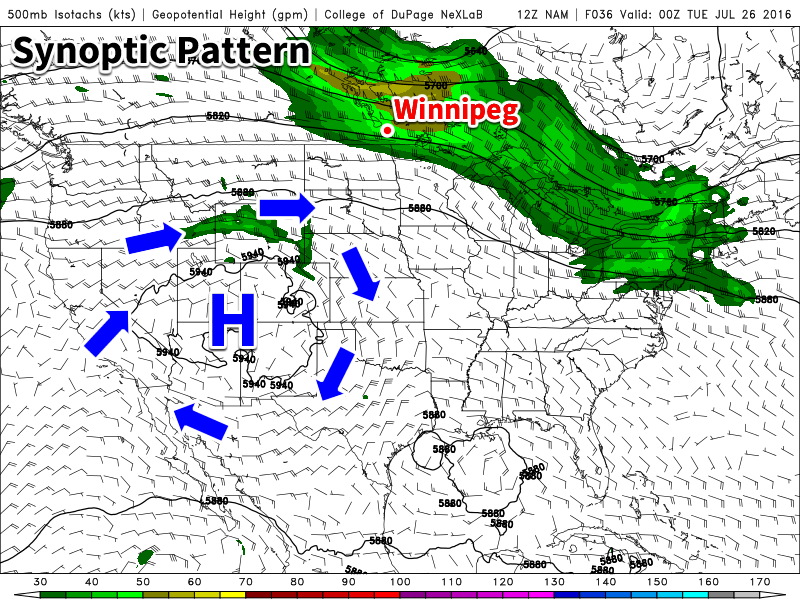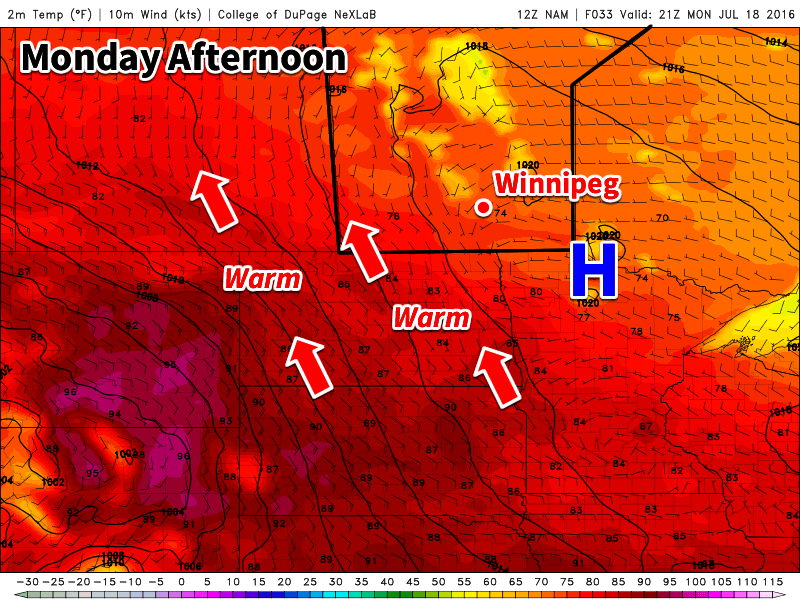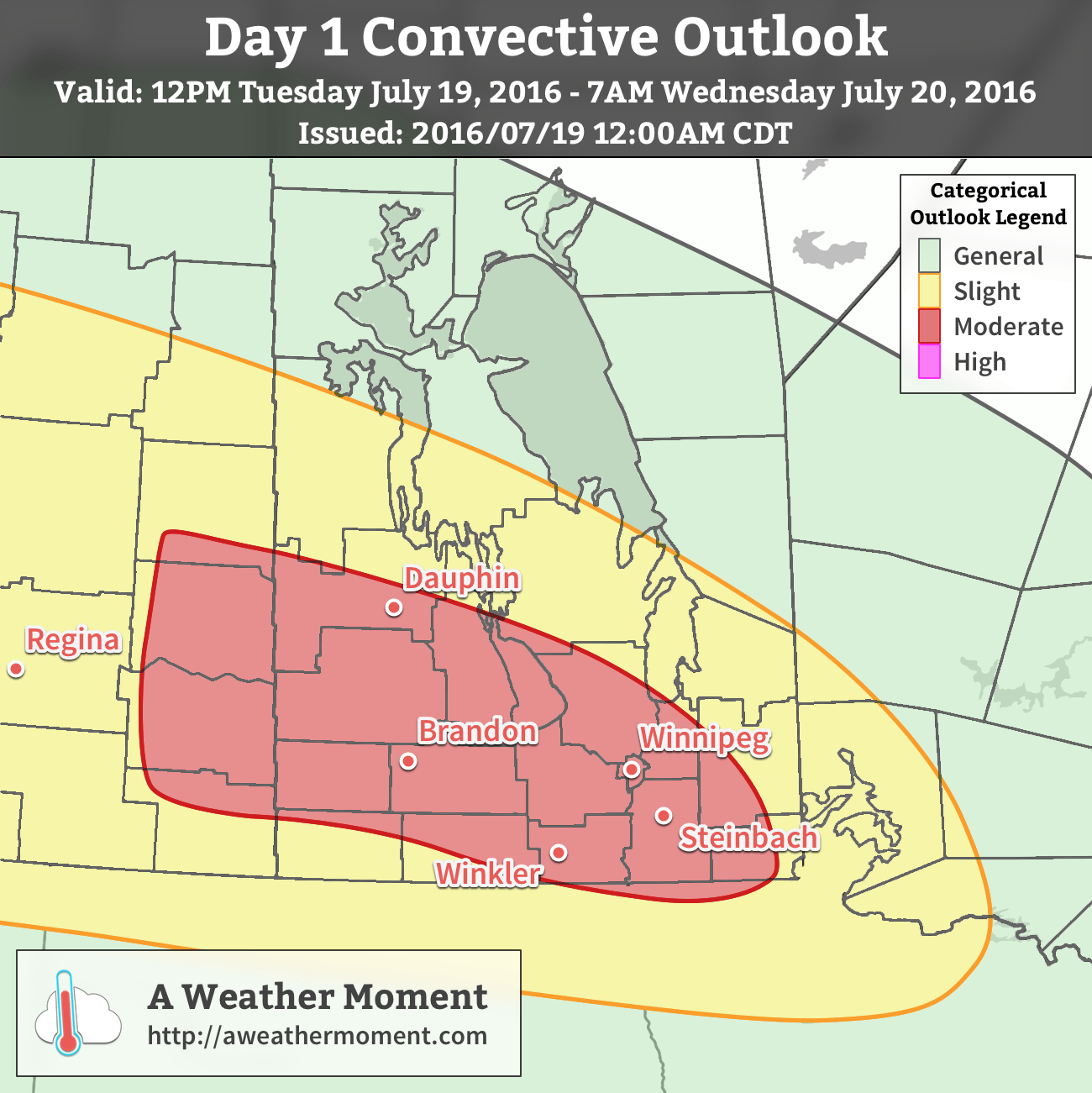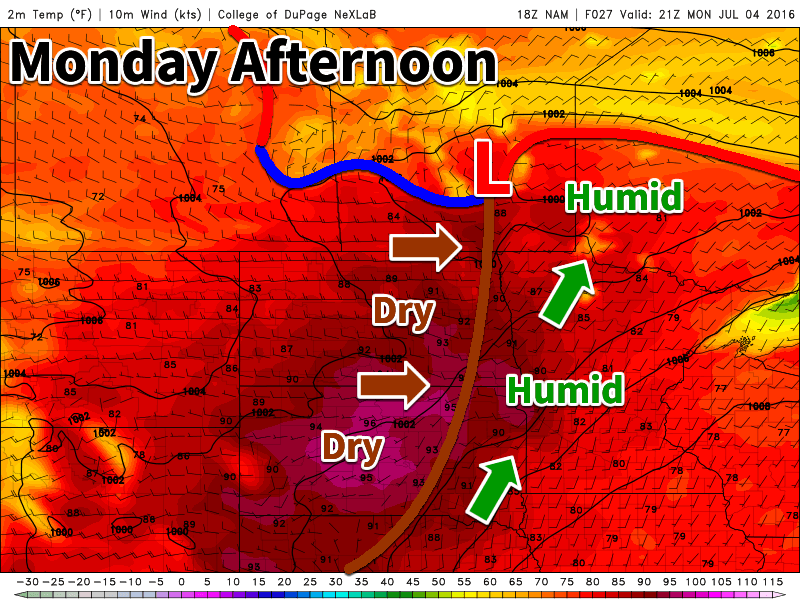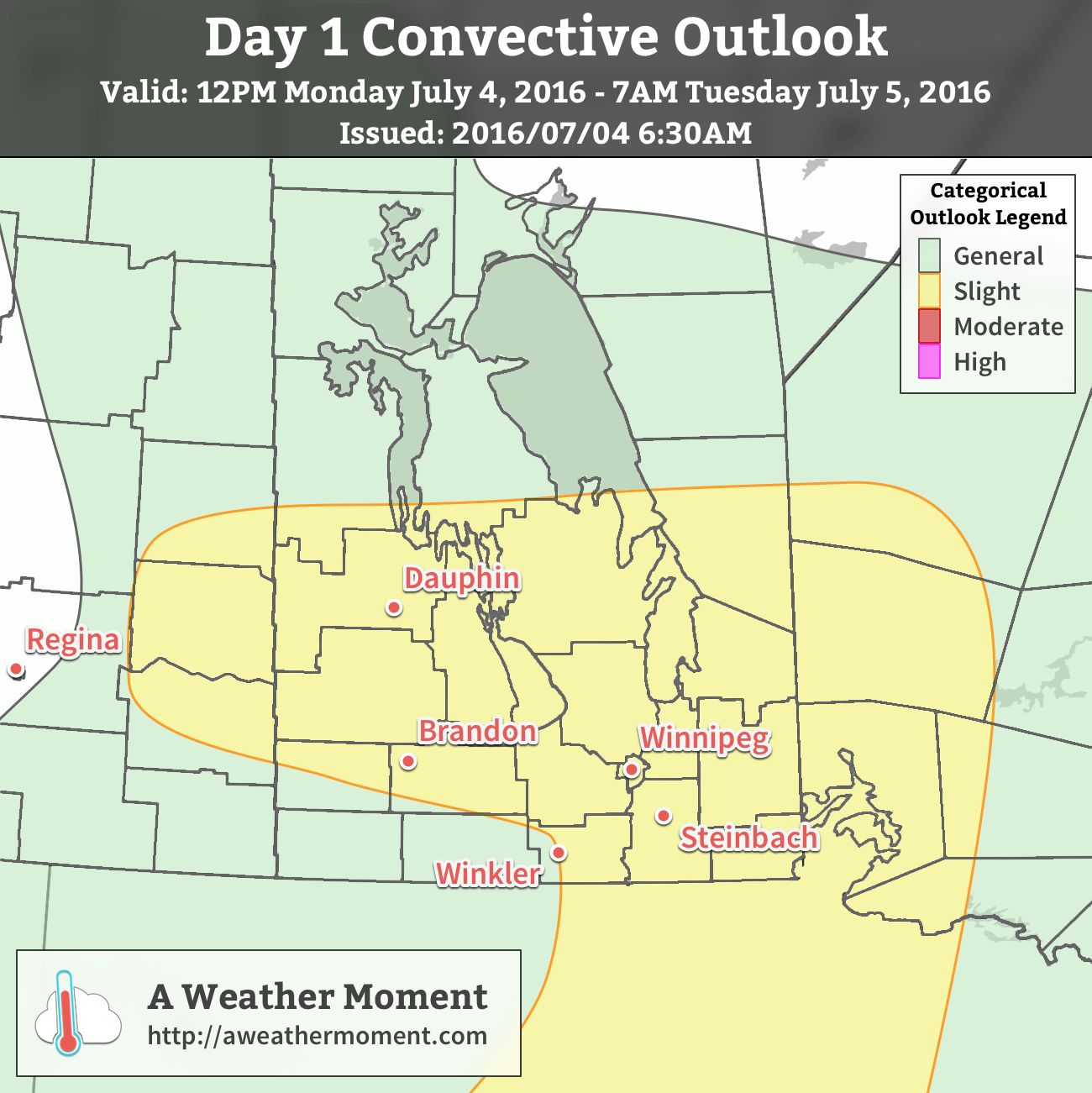This week will start out with another risk of severe thunderstorms across southern Manitoba. On the bright side, conditions prior to the storms will be warm.
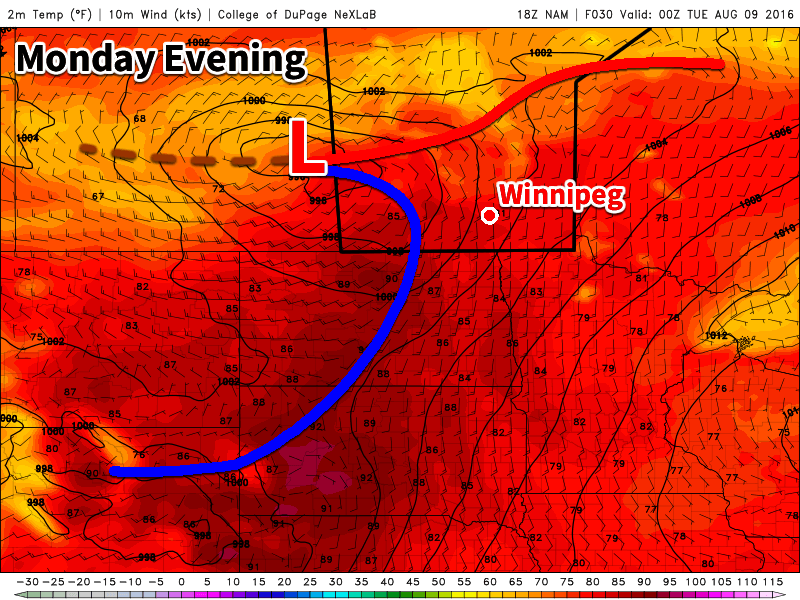
This Week
Today will be a warm and increasingly humid day across southern Manitoba. High temperatures will generally be in the upper twenties, although some locations may reach the 30C mark. The increased humidity will push humidex values into the mid-upper thirties. The approach of a strong low pressure system will result in a stiff southerly wind developing across southern Manitoba. Wind speeds in the Red River Valley will be 40 km/h gusting to 60 km/h by late afternoon. Other portions of southern Manitoba will also be windy, but with speeds perhaps a bit lower than those in the RRV. This same low pressure system will bring a risk of severe storms to most of southern Manitoba as a cold front slices into this warm, humid air mass. All hazards will be possible with storms that develop, with the primary risks being large hail and damaging wind gusts. Tornadoes will be possible with any storms that remain isolated, although the tornadic risk is somewhat lower than last Wednesday.
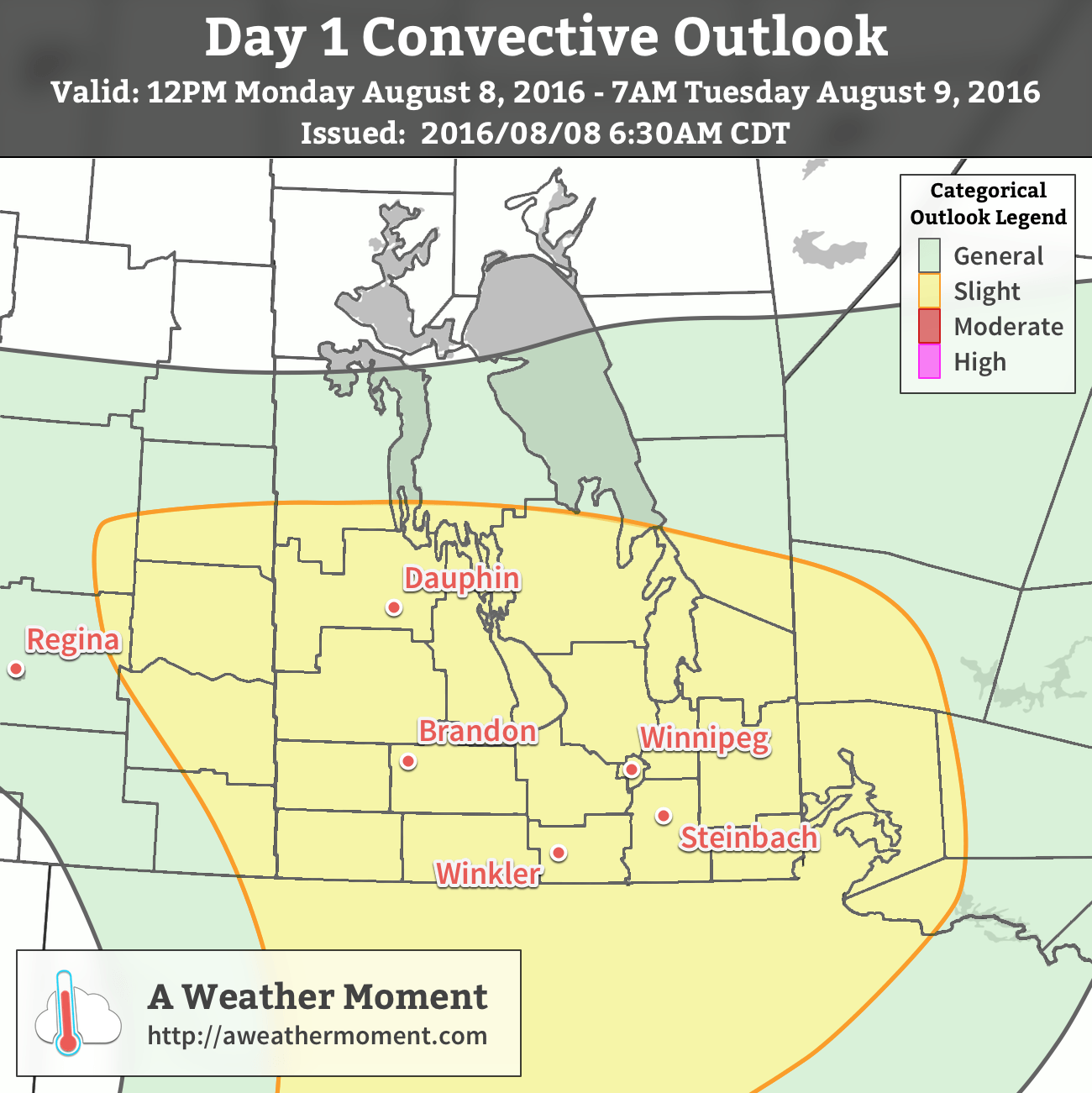
Models hint at an organized convective system perhaps developing out of the afternoon/evening storms. Should such a scenario play out, the Red River Valley and southeastern Manitoba may be at risk for more widespread damaging winds from the evening into the overnight period.
Instability: The aforementioned well-mixed boundary layer will sit beneath mid-level lapse rates of approximately 7 C/km. Steep low-level lapse rates will be present owing to the well-mixed, and relatively deep boundary layer. Resulting MLCAPE values will be near 2000-2500 J/kg across south-central Manitoba by early evening. Early evening instability will generally be poor in the Red River Valley and points east, with MLCAPE of 1000 J/kg or less. However, by the late evening period (03Z onward), MLCAPE/MUCAPE will increase to near 2000 J/kg in the region.
Wind Shear: A 50 kt 500-mb jet streak pushing into SW Manitoba will be preceded by approximately 40 kt of westerly flow over southern Manitoba. Except near the surface warm front, surface winds will generally be southerly, and as a result will not enhance the effective bulk wind difference (EBWD) in a notable way. The result will be EBWD values of 30-40 kt across southern Manitoba, with locally higher values near the surface warm front. More interestingly, a strong southerly low-level jet of 30-40 kt is expected over south-central Manitoba by late afternoon. This will result in 0-1 km wind shear of 15-25 kt. Effective storm relative helicity values will also be strong, at 250-400 m2/s2 during the evening. Low-level shear and helicity are also expected to benefit from the decoupling of the boundary layer by mid-late evening, as the LLJ increases to 45 kt by 0300 UTC.
Trigger: The primary trigger for deep convection Monday evening will be a cold front moving in from eastern Saskatchewan and a warm front extending eastward from a low pressure system near the MB/SK border. Forcing for ascent will be quite strong, especially over western Manitoba, where a potent shortwave trough will help knock down heights by the afternoon. The combination of the low-level mesoscale ascent with the surface fronts and mid-level ascent from the incoming shortwave should easily be able to trigger storms by late afternoon across western Manitoba.
Discussion: Severe thunderstorms are likely to develop across western Manitoba/central Interlake beginning Monday afternoon. Initial storms will likely be a mix of supercells and multicell clusters, owing to the strong forcing. Any initial cells that are able to maintain relatively unpolluted surface-based inflow will present a tornado risk, owing to the strong low-level shear/helicity and steep low-level lapse rates. All initial severe cells will be capable of large hail and damaging wind gusts. As the evening progresses, some models hint at upscale growth/cold pool mergers leading to the development of a bowing system over the southern interlake, or adjacent regions. Should such a system develop and have a significant line-trailing cold pool, it would tend to move ESE/SE, potentially impacting Winnipeg, the Red River Valley, and southeastern Manitoba. A system will a less pronounced cold pool may take a most easterly track, primarily avoiding the Red River Valley. Latest models suggest a well-organized, cold-pool driven MCS is the less likely outcome. The overall risk is slight for all of southern Manitoba. A future moderate risk is possible should a forward-propagating system become more likely.
The cold front which triggered today’s storms will pass through the Red River Valley early Tuesday, likely bringing with it some showers and/or weak thunderstorms. After the front clears the region, skies will begin to clear, allowing temperatures to climb into the low twenties by afternoon. Winds will be northerly at 20-30 km/h behind the front.
Wednesday’s forecast remains fairly uncertain at this point. Models hint at the potential for rain across much of southern Manitoba, though the amount and duration of this rain is quite uncertain. Some models bring significant rain to the region, while others bring only light showers. It appears regions along the international border may be at the highest risk for significant accumulations, though that could change as new data becomes available. Outside the rain, skies will be mainly cloudy with temperatures near 20C. Winds will be easterly at 20-30 km/h.
Long Range
The long range forecast shows little change in our pattern over the next couple weeks. Expect to see 1 or 2 weather systems rolling through our region every week, with stormy conditions associated with the passage of each system. Between systems we can expect generally pleasant conditions, with temperatures near to above-seasonal values.
